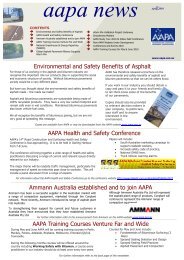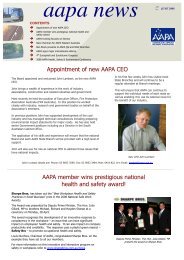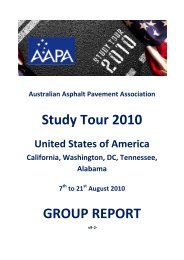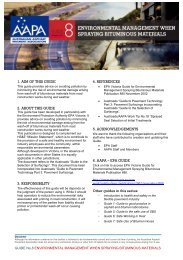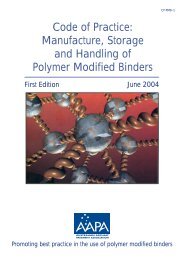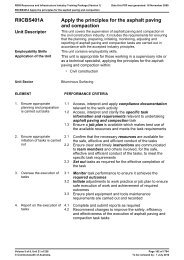Asphalt Review - Feb/March 2013 - Australian Asphalt Pavement ...
Asphalt Review - Feb/March 2013 - Australian Asphalt Pavement ...
Asphalt Review - Feb/March 2013 - Australian Asphalt Pavement ...
You also want an ePaper? Increase the reach of your titles
YUMPU automatically turns print PDFs into web optimized ePapers that Google loves.
Phillip Island Grand Prix Track Resurfacing<br />
Phillip Island Grand Prix Circuit is a place that stirs emotions in motor<br />
sport fans around Australia, whether it be V8 Supercars, Moto GP or<br />
World Superbikes. The combination of a fast flowing world-class circuit<br />
married with a picturesque setting on the coastline of Victoria’s Phillip<br />
Island make this a special place.<br />
When the circuit operators – PI Operations, which is charged with<br />
managing the circuit for owner Linfox – reaslised it was time for a<br />
new wearing surface, it looked into its history to guide a pathway for<br />
selecting a new asphalt wearing surface.<br />
Downer Australia East Chief Operating Officer, Sergio Cinerari, had<br />
been intimately involved in the previous two upgrades and asphalt<br />
overlays at the circuit in 1989 and 1998. The upgrade in 1989 was<br />
probably the most significant performed on the circuit in its history. The<br />
circuit was widened to around 10m and significant asphalt correction<br />
work performed to iron out bumps prior to a full width overlay.<br />
These works were to prepare the circuit for its first event on the<br />
world stage in late 1989, the first <strong>Australian</strong> Moto GP. The upgrade<br />
works were performed in 1989 utilising a small 100 tonne per hour<br />
mobile asphalt plant established on the site.<br />
By 1998, the circuit was in need of a new wearing surface. The works<br />
performed in 1989 had stood the test of time, so the scope in 1998<br />
was to purely overlay the circuit. This time, the asphalt was produced<br />
in Melbourne and carted to Phillip Island where it was put through a<br />
transfer vehicle and placed over four days. The paving method involved<br />
completing a half-circuit of the track each day at 5m wide, resulting in<br />
two transverse joins and a full length longitudinal cold join around the<br />
centre of the track.<br />
The mix placed in 1998 was a 14mm dense graded mix with C320<br />
binder which performed admirably for over 13 years. It was due to<br />
the success of the previous two upgrades and overlays that Fergus<br />
Cameron, Managing Director of PI Operations contacted Sergio Cinerari<br />
in <strong>Feb</strong>ruary 2012 to commence the process of planning for the next<br />
overlay scheduled for December 2012.<br />
Right from the first meeting, the team from Linfox were very clear on<br />
their goal, they wanted the “best racetrack in the world”. PI Operations<br />
also employed the services of Aurecon to work with Downer and the<br />
wider Linfox team to determine the most cost effective solution to<br />
meet their goals. The only high-level constraints were that this was to<br />
be a remove-and-replace operation, not a pure overlay on top of the<br />
existing surface; the mix needed to have a similar look and texture to<br />
the existing surface and the general geometry of the track needed to<br />
remain the same.<br />
Over a period of a couple of months, the methods available to deliver<br />
the works were developed and costed, along with the advantages and<br />
risks associated with each delivery method. At the same time, work<br />
ROADS FEB/MARCH <strong>2013</strong> 31



